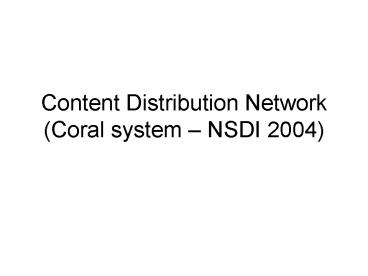Content Distribution Network Coral system NSDI 2004 - PowerPoint PPT Presentation
1 / 19
Title:
Content Distribution Network Coral system NSDI 2004
Description:
Forward phase. Putter send RPCs to nodes en route close to key. Stop at full and loaded node ... and control of flash crowd problem. Clustering. Ability ... – PowerPoint PPT presentation
Number of Views:25
Avg rating:3.0/5.0
Title: Content Distribution Network Coral system NSDI 2004
1
Content Distribution Network(Coral system NSDI
2004)
2
Background
- DHT
- Key space
- Overlay network
- Web caching
- proxies
- Content Distribution Network
- e.g. Akamai
- Problem being addressed by Coral
- Scalable content distribution
- Avoid slashdot effect
3
Takeaway
- Novel key/value indexing called Coral
- Weaker consistency than traditional DHT
- DSHT where S stands for Sloppy
- Locality
- Hot spot prevention
- CoralCDN
- Self-organizing decentralized
- Locate nearby cached copies without querying
distant nodes - Avoids slashdot effect
- Interoperates with unmodified web browsers
4
Coral Indexing DSHT
- Nodes are organized into clusters
- Cluster
- Maximum desired RTT (diameter)
- Hierarchy of diameters levels
- Level 0 infinity
- Level 1 60 ms
- Level 2 20 ms
- API
- Put (key, value, ttl, levels)
- Get (key, levels)
- Nodes (level, count, target, services)
- Levels()
5
Coral System
6
CoralCDN components
- DNS server
- Returns Coral proxies for client query from a
browser (through a resolver) - Coral HTTP proxy
- Proxy selection based on client locality
- Get from peer proxies (using Get) if at all
possible - Goal is to reduce load on origin server
- Flash crowd
- Automatically form a (sort of) multicast tree
7
Coral key based routing
8
- Basic idea in routing
- Reduce distance to desired destination by
(approx) half in each iteration - Reduces overloading nodes close to the key
- Potential longer latency during lookup
- Tradeoff to avoid tree saturation (due to
slashdot effect)
9
Sloppy storage
- Put and Get in other DHT
- All proceed to node closest to key
- Coral
- Often satisfied by nodes other than those close
to key - Two phase put
- Node attribute full, loaded
- Forward phase
- Putter send RPCs to nodes en route close to key
- Stop at full and loaded node
- Reverse phase
- Pick a node that is closest to the key as the
destination for the put - Multiple values may be stored for a key
10
- Get (retrieval)
- Remote peer (for k) returns values
- Application dependent action on values returned
- E.g. Coralproxy
- Values are locations of files that hash to k
- parallel download of files from the multiple
locations
11
Hierarchical operations
- Hierarchical retrieval using clusters
12
- Hierarchical insertion
- Start put in level 2 cluster
- Continue putting in level 1 cluster
- Loose hierarchical cache
13
Cluster management
- Joining node contacts an existing peer node to
join - A node will join only an acceptable cluster
- Latency limit for the cluster and RTT results to
the members of the cluster - All RPC results cluster contain meta data for
fine tuning the cluster membership
14
Implementation
- Coral
- 14K lines of C
- DNSserv
- 2K lines of C
- HTTP proxy
- 4K lines of C
15
Evaluation
- Load distribution and control of flash crowd
problem - Clustering
- Ability to self-manage clusters
- No hot spots in the indexing system
16
Experimental setup
- 166 Plantelab machines seeded with a host name
- Run coral daemon, dnsserv, coralproxy on each
- Unmodified Apache web server on host
- Clients on the planetlab machines start
generating requests
17
Server load results
18
Client latency
19
Clustering































